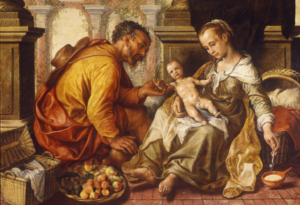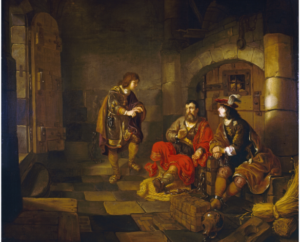Tapestries on the Life of King Hezekiah: The Destruction of the Idols by Hezekiah, The Sacrifice of Hezekiah, and Hezekiah’s Life Prolonged
Signed: unknown weaver’s mark (bottom right)
Woven wool and silk tapestry
Designed by Jan Cornelisz. Vermeyen
Flanders, active 16th century
Woven by the Weaver of the Hezekiah Series (of the Royal Swedish Collection in Stockholm), also known as the Weaver of the Book of the Kings Series (of the Royal Collection in Vienna)
Brussels, c. 1530
Click on the links throughout the article to view additional artists’ works and reference material.
During these winter months, we turn up the thermostat, put on a sweater, or throw an extra blanket on the bed when the temperatures drop. Insulation, thermal-pane windows, and caulking keep our houses snug from winter’s chill. But what if your home was a drafty castle with no warmth except near the fireplace? If you were wealthy enough, tapestries would provide some insulation to keep the winter winds out and the meager warmth in. The tapestry’s portability was an added bonus. When one residence got particularly smelly or otherwise unsuitable, the artistic insulation could be rolled up and transported to the next home. Of course, we view tapestries today primarily as works of art, without much thought as to their original practical purposes.
When you step into the Lobby at the Museum & Gallery at Bob Jones University, some of the first works of art you encounter are three tapestries, each measuring 13 feet x 11.5 feet. They depict three scenes from the life of King Hezekiah, ruler of Judah in the 8th and early 7th centuries BC. The tapestries were produced in Brussels, Brabant (before Belgium existed as a country) in the early 16th century, and by the early 17th century they graced the walls of Somerset House in London, residence of Queen Henrietta Maria, wife of King Charles I. Since tapestries were considered the most valuable objects of their time, only royalty or the very wealthy would have owned them. With the beheading of Charles I, the tapestries became possessions of Cromwell’s Commonwealth. Later sales trace them to Spain and then New York. M&G acquired them in 1965.
The Bible records details of Hezekiah’s life in 2 Kings 18–20, Isaiah 36–39, and 2 Chronicles 29–32. As one of Israel’s moral, godly rulers, Hezekiah is depicted in the first two tapestries destroying idols and restoring temple sacrifices to draw his countrymen back to serving and worshiping the one true God genuinely, purely, and wholeheartedly. The third tapestry shows an incident where Hezekiah was gravely ill and requested a longer life from the Lord; God answered his prayer and miraculously healed him. The Latin phrases at the top of each tapestry describe the events of each pictured scene.
Anne Short, Volunteer Collection Researcher & Retired Docent
Published in 2016


